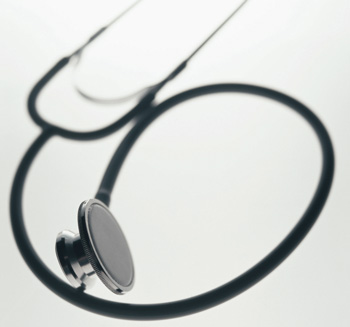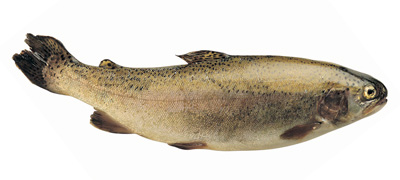YOUR HEALTH
TECH IN THE WORLD OF MEDICINE: A NEW STETHOSCOPE FOR THE 21ST CENTURY IS HERE
The first stethoscope was accidentally invented in 1816. In Paris, a prominent physician was treating a woman for heart disease. Modestly, she refused to let him put his head to her chest. So he made a paper cylinder and applied one end to her chest and the other to his ear. Eureka! He could hear the action of her heart more clearly than by the head-to-chest method.
Science and time have replaced the paper cylinder with flexible plastic tubing attached to a chest piece. In our time, however, it contains a miniature electronic sensor or amplifier.
Stethoscopes are used for more than listening to the chest. They can listen to the sounds of air flow in the lungs, blood flow in major vessels and more. It's recognized as the symbol of modern medicine.
John Swartzberg, M.D., says there's a good chance the stethoscope will join the doctor's bag and the house call as reminders of old time medicine. Swartzberg, chair of the editorial board at BerkeleyWellness.com, says powerful new hand held ultrasound devices are on the verge of replacing the stethoscope.
Many experts think it's a good idea. Young doctors are less skilled at using stethoscopes than they should be. The obesity epidemic has made the stethoscope harder to use since body fat can muffle interior sounds. Ultrasound devices offer a more accurate diagnosis of heart, lung and other problems, as well as assisting many kinds of medical specialists.
Data recorded by the devices can be saved and shared with other clinicians. They are especially helpful in the developing world where access to medical imaging technology is limited. Some doctors use both the stethoscope and the ultrasound devices.

PREVENTING KIDNEY DISEASE
Almost six in 10 Americans will develop kidney disease in their lifetimes, according to a study published in the American Journal of Kidney Disease. Individuals age 60 or older, those with diabetes or high blood pressure, should be checked for chronic kidney disease (CKD) by a simple urine test at their annual physical.
There has been a six fold increase in the number of CKD cases in the United States since 1980. The Northwest Kidney Centers say there are certain things you can do to help keep your kidneys healthy.
- One is to avoid a high sodium diet. It's one of the most important things you can do.
- Avoid illegal drugs and the overuse of prescription and over the counter drugs
- Control your blood pressure; reduce high blood pressure with medication prescribed by your doctor.
- Know your family health history. If there is hypertension or diabetes in the family have your kidney function checked every year.
- Quit smoking. Check the Internet for programs that will help you quit.
If you have concerns about being at risk for chronic kidney disease talk to your doctor and get screened.
WEAR TREATED CLOTHING TO PREVENT TICK BITES
Wearing clothing that's pretreated with the insect repellent permethrin significantly reduced tick bites in outdoor workers. They were compared with those taking routine tick prevention measures, according to a study reported in the May issue of the American Journal of Preventive Medicine.
About 34,000 cases of tick related diseases are reported to the Centers for Disease Control and Prevention each year. The active ingredient in permethrin controls a wide variety of crawling and flying pests, including ticks, fleas, lice, and mosquitoes.
Permethrin should be sprayed on clothing but not while it's being worn. It should not be sprayed directly on the skin. This insecticide is often used for camping gear, including tents. See sawyer.com for a complete video of how to use permethrin.
READ THIS: IT COULD GIVE YOU A NEW IDEA OR TWO.
The Vision Council advice on digital eye strain
Remember the 20-20-20: Every 20 minutes, take a 20 second break and look at something 20 feet away. Decrease background brightness. Maybe change it from a bright white to a cool gray. Adjust the screen. Make it directly in front of your face and slightly below eye level. Lessen overhead light. It can compete with your device's screen.
Coordinate the chair and monitor. In your chair extend you arm. Your palm should rest comfortably on the monitors if you're high-fiving the screen. Keep handheld devices a safe distance from your eyes and below eye level.
Increase the text size. You'll spot any mistake easily and it will be easier on our eyes. Some programs let you do it instantly. Others make you use control settings to make adjustments that feel comfortable to your eyes. Remind yourself to blink more often. Staring at a digital screen affects the number of times you blink, leading to dry eyes. according to Sheila Bair former FDIC chair.
'A-FIB': THE SERIOUS HEART CONDITION MEN DON'T KNOW THEY HAVE
Middle-aged men understand they should pay attention to their diet and get some exercise in order to keep their heart healthy. However, they probably don't know what atrial fibrillation (A-fib) is or how they would feel if it struck them.
Atrial fibrillation, or A-fib, is an electrical disruption in the rhythm of the upper chambers of the heart. Instead of a firm, rhythmic pump, the heart's atria suddenly pump randomly and seem to flutter. When this happens, blood flow weakens.
The way it feels is a lot less scientific. You can sense a humming sound, then dizziness, nausea, disorientation and chest pain. The A-fib can cause a stroke and, in fact, it raises your risk of stroke five fold.
Doctors don't know what causes it, and can't predict who'll get it. Extreme exercise is a factor, but everyone is a possible target, especially after age 50. But men get it at a much younger age than women.
Many ignore the symptoms, like a rapid, irregular and weak pulse, shortness of breath, weakness or confusion, because the symptoms are gone within a few minutes.
There are three types of A-fib: the kind that comes and goes and the chronic type that won't go away. The "lone" type, strikes younger patients out of the blue, giving them a stroke.
A-fib can be controlled simply by taking a daily pill. If you have the symptoms see a doctor right away.
The facts on A-fib:
- 2.7 million Americans have it and the majority are over 50.
- Average age for men with A-fib is 66.8; for women, 74.6.
- African-Americans are 50 percent less likely to get A-fib than are other races.
- 15 percent of all strokes are caused by A-fib.
GROUPS ARGUE FOR EXPERIMENTAL DRUGS
The frightening, untreatable, ALS or Lou Gehrig's disease takes its victims from twitch to total paralysis and there is nothing anyone can do about it. Except that maybe there is. However, most all ALS sufferers can't get the new experimental drug.
The new drug is currently in phase 1 trials, the first step in an arduous, bureaucratic process of drug approval. Those fortunate to have gone into the first clinical trial can now walk, when once they could not.
According to Darcy Olsen, president of the Goldwater Institute, about 5,000 ALS patients will die this year. Should they be able to try the new drug, too? Colorado Gov. John Hickenlooper signed a "Right to Try" bill designed to give terminal patients a chance to try experimental drugs before they are approved by the FDA. And the movement is picking up steam as lawmakers in Louisiana and Missouri recently approved Right to Try bills. Arizona voters will test the issue in November.
It can take 10 years to get FDA approval, something even the FDA knows is too cumbersome. In March it called for comments on ways to streamline its tangled system that delays drugs and even makes it difficult to add safety warnings for labels.

RESEARCHERS HAVE MORE KUDOS FOR COFFEE
It's not big news that drinking two to four cups of coffee a day has a number of health benefits. Researchers have already proved it reduces the risk of Parkinson's disease, type 2 diabetes, liver cancer, Alzheimer's disease and dementia.
New studies published in the Archives of Internal Medicine show that caffeine is linked to a lower risk of stroke, skin cancer and depression. The researchers say caffeine may be the key protective ingredient since decaffeinated coffee consumption was not associated with the benefits in these studies.
Dietitians at Weill Cornell Medical College say coffee contains other healthy ingredients that may provide defenses against multiple conditions. It is rich in antioxidants that can protect against cancer, heart disease and other chronic diseases. But they can't just say it's coffee that makes people healthier because there are so many variables.
The depression study included 50,000 women at about 63 years of age. Those who drank four 8 ounce cups of caffeinated coffee daily were 20 percent less likely to become depressed. The cancer study found that drinking about four cups a day was associated with the lowest risk of basal cell carcinoma, a type of skin cancer.
A stroke study reported in the American Journal of Epidemiology didn't pinpoint how coffee affected the brain, but three to four cups a day protected it from stroke. Drinking more than that did not increase protection.
STAYING WELL RESEARCH: TAKE A FISH OIL SUPPLEMENT
A great deal of research suggests that a diet rich in fish oil can be good for both the brain and the heart. Still other studies show that fish oil's omega-3 fatty acids may delay age related cognitive decline.
To get enough omega-3s, people would have to eat oily kinds of fish about five times a week, but taking fish oil supplements can help.
The benefits are still under study. Some claim taking fish oil pills has little effect on heart health or strokes. However, the American Heart Association believes the supplements benefit healthy people as well as those at risk for heart disease.
"I recommend them to most of my patients after 50," says Gina Lundberg, a spokesperson for the Heart Association and an assistant professor of medicine at the Emory University School of Medicine in Atlanta.
"Not just for the triglyceride lowering benefit and cardiovascular benefit but for the powerful antioxidant and brain power benefits," she says.
Those who want to take supplements should choose those that contain at least 1,000 milligrams of EPA and DHA, but they should still eat fatty fish twice a week. These include wild salmon, trout, sole, sardines and herring.

FOR A SUMMER COLD, TRY ZINC
If you're watching your favorite TV show when you notice your throat is feeling a little tight and sore, these are the first signs. You're getting a cold.
A number of studies show that people who take zinc within the first day of an illness will develop milder symptoms or feel better more quickly.
The official limit for zinc is 40 milligrams a day for adults, but you can safely take a little more than that if you take it for only a few days. Try a zinc lozenge or syrup to get it into contact with the cold virus in your throat, says the National Institutes of Health.
NEW OSTEOPOROSIS DRUG BUILDS BONE, REDUCES REABSORPTION
While it's still in the experimental stage, a drug called romosozumab could change treatment methods for osteoporosis and help to prevent fractures. Research by Michael McClung, MD, founder and director of the Oregon Osteoporosis Center, and colleagues at medical centers around the world, confirm that the drug increases bone density (BMD) and increases bone formation.
Romosozumab (roe moe soz' ue mab) was compared with two drugs, Forteo and Fosamax, in 400 women ages 55 to 85 over 12 months. For this Phase 2 testing all had been diagnosed with osteopenia, low bone mass but not low enough to be called osteoporosis.
The injected drug increased BMD in the spine by 11.3 percent compared to 7.1 percent with Forteo and 4.1 percent with Foamax. Increases were noted at three, six and 12 months.
At the same time, there was a significant reduction in bone reabsorption (breakdown). Doctors at Duke University explain that aging causes more bone to be broken down than rebuilt resulting in reduced bone mineral density.
No significant side effects in test subjects were noted. Larger Phase 3 testing is in progress.
HOW TO PROTECT YOUR KNEES AND AVOID REPLACEMENT SURGERY
According to the American Academy of Orthopaedic Surgeons, knee joints are responsible for sending nearly 15 million Americans to the doctor every year. Here's how to protect your knees and avoid knee replacement.
Don't ignore pain. "Knowing when you can and can't ignore pain is key," says sports medicine specialist Jordan Metzl, MD, from the Hospital for Special Surgery in New York City:
When to see a doctor. When pain limits your ability to do what you normally do you need to have it checked.
Diagnosis. For one patient, exploratory surgery revealed a torn meniscus followed by the more recent anterior cruciate ligament (ACL) tear. If the first injury had been repaired the ACL tear might not have happened.
Women and the ACL. Women have a two to eight times higher risk for tears compared to men. This happens mainly because the way women jump, land, and turn puts greater strain on the ACL.
Retraining. All athletes can be trained to lower risks of knee injury. It's done through neuromuscular training which involves supervised practice in improving agility, leg strength, and jump landing techniques. These specialized techniques are effective in reducing risks of knee injury by almost one-half.
Don't over do it. A sudden increase in intensity or duration of exercise or sports practice can cause overuse injuries like tendonitis and kneecap pain.
Strengthen muscles around the knees. Weak muscles and lack of flexibility are primary causes of knee injuries, according to the Mayo Clinic. When the muscles around the kneecap, hip, and pelvis are strong, it keeps the knee stable and balanced.
Watch your weight. Being overweight increases your chances of osteoarthritis in the knee, an often disabling form of arthritis that wears away the knee's cushiony cartilage. According to the CDC, two out of three obese adults suffer from knee osteoarthritis at some time in their lives.
© 2014 TLC Magazine Online, Inc. |